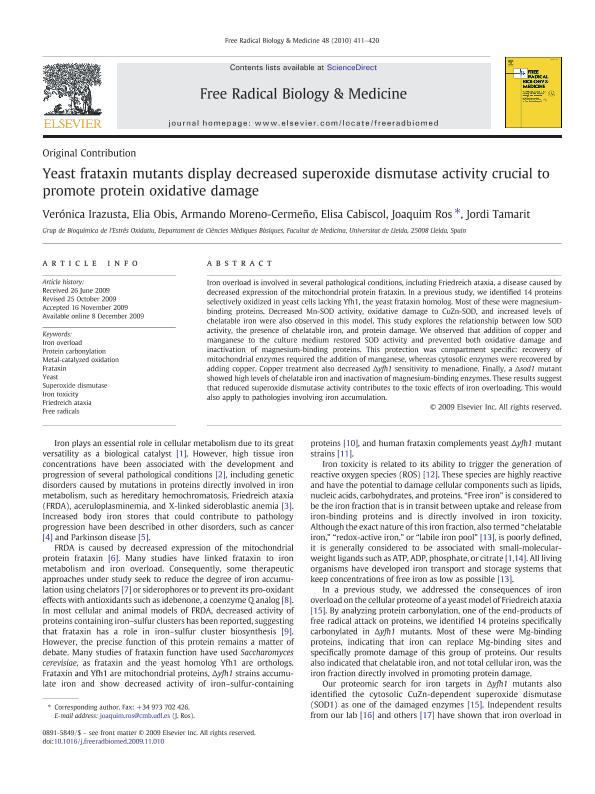Artículo
Yeast frataxin mutants display decreased superoxide dismutase activity crucial to promote protein oxidative damage
Irazusta, Verónica Patricia ; Obis, Elia; Moreno Cermeño, Armando; Cabiscol, Elisa; Ros, Joaquim; Tamarit, Jordi
; Obis, Elia; Moreno Cermeño, Armando; Cabiscol, Elisa; Ros, Joaquim; Tamarit, Jordi
 ; Obis, Elia; Moreno Cermeño, Armando; Cabiscol, Elisa; Ros, Joaquim; Tamarit, Jordi
; Obis, Elia; Moreno Cermeño, Armando; Cabiscol, Elisa; Ros, Joaquim; Tamarit, Jordi
Fecha de publicación:
01/02/2010
Editorial:
Elsevier Science Inc
Revista:
Free Radical Biology and Medicine
ISSN:
0891-5849
Idioma:
Inglés
Tipo de recurso:
Artículo publicado
Clasificación temática:
Resumen
Iron overload is involved in several pathological conditions, including Friedreich ataxia, a disease caused by decreased expression of the mitochondrial protein frataxin. In a previous study, we identified 14 proteins selectively oxidized in yeast cells lacking Yfh1, the yeast frataxin homolog. Most of these were magnesium-binding proteins. Decreased Mn-SOD activity, oxidative damage to CuZn-SOD, and increased levels of chelatable iron were also observed in this model. This study explores the relationship between low SOD activity, the presence of chelatable iron, and protein damage. We observed that addition of copper and manganese to the culture medium restored SOD activity and prevented both oxidative damage and inactivation of magnesium-binding proteins. This protection was compartment specific: recovery of mitochondrial enzymes required the addition of manganese, whereas cytosolic enzymes were recovered by adding copper. Copper treatment also decreased Δyfh1 sensitivity to menadione. Finally, a Δsod1 mutant showed high levels of chelatable iron and inactivation of magnesium-binding enzymes. These results suggest that reduced superoxide dismutase activity contributes to the toxic effects of iron overloading. This would also apply to pathologies involving iron accumulation.
Archivos asociados
Licencia
Identificadores
Colecciones
Articulos(PROIMI)
Articulos de PLANTA PILOTO DE PROC.IND.MICROBIOLOGICOS (I)
Articulos de PLANTA PILOTO DE PROC.IND.MICROBIOLOGICOS (I)
Citación
Irazusta, Verónica Patricia; Obis, Elia; Moreno Cermeño, Armando; Cabiscol, Elisa; Ros, Joaquim; et al.; Yeast frataxin mutants display decreased superoxide dismutase activity crucial to promote protein oxidative damage; Elsevier Science Inc; Free Radical Biology and Medicine; 48; 3; 1-2-2010; 411-420
Compartir
Altmétricas



